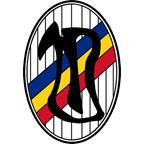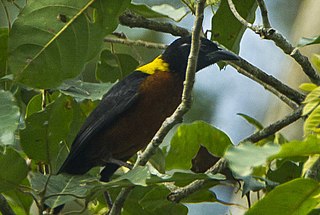Related Research Articles

The national flag of Slovenia features three equal horizontal bands of white (top), blue, and red, with the Slovene coat of arms located in the upper hoist side of the flag centered in the white and blue bands. The coat of arms is a shield with the image of Mount Triglav, Slovenia's highest peak, in white against a blue background at the center; beneath it are two wavy blue lines representing the Adriatic Sea and local rivers, and above it are three six-pointed golden stars arranged in an inverted triangle which are taken from the coat of arms of the Counts of Celje, the great Slovene dynastic house of the late 14th and early 15th centuries.

The flag of Italy, often referred to in Italian as il Tricolore ; is a tricolour featuring three equally sized vertical pales of green, white and red, with the green at the hoist side. Its current form has been in use since 18 June 1946 and was formally adopted on 1 January 1948.
Tricolor or tricolour, or tricolored, tricoloured, may refer to:

The national flag of Afghanistan consists of a vertical tricolor with the classical National Emblem in the center. The current flag was adopted on August 19, 2013, but many similar designs had been in use throughout most of the 20th century.

The tricolored heron, formerly known as the Louisiana heron, is a small species of heron that is native to coastal parts of the Americas. In the Atlantic region in ranges from northeastern United States, south along the coast, through the Mexican Gulf and the Caribbean, to northern South America as far south as Brazil. In the Pacific region it ranges from Peru to California, but it is only a non-breeding visitor to the far north.

Viola tricolor, also known as Johnny Jump up, heartsease, heart's ease, heart's delight, tickle-my-fancy, Jack-jump-up-and-kiss-me, come-and-cuddle-me, three faces in a hood, or love-in-idleness, is a common European wild flower, growing as an annual or short-lived perennial.

The tricolored bat is a species of microbat native to eastern North America. Formerly known as the eastern pipistrelle, based on the errant belief that it was closely related to European Pipistrellus species, the closest known relative of the tricolored bat is now recognized as the canyon bat. Its common name "tricolored bat" derives from the coloration of the hairs on its back, which have three distinct color bands. It is the smallest bat species in the eastern and midwestern US, with individuals weighing only 4.6–7.9 g (0.16–0.28 oz). This species mates in the fall before hibernation, though due to sperm storage, females do not become pregnant until the spring. Young are born helpless, though rapidly develop, flying and foraging for themselves by four weeks old. It has a relatively long lifespan, and can live nearly fifteen years.

Unirea Tricolor Bucureşti was a Romanian football club from Bucharest, south-east Romania, founded in 1926 when two clubs, Unirea Bucureşti and Tricolor Bucureşti merged.

Sampaio Corrêa Futebol Clube, usually known as Sampaio Corrêa, is a Brazilian association football club from São Luís, Maranhão state, founded on March 25, 1923.

In the mathematical field of knot theory, the tricolorability of a knot is the ability of a knot to be colored with three colors subject to certain rules. Tricolorability is an isotopy invariant, and hence can be used to distinguish between two different (non-isotopic) knots. In particular, since the unknot is not tricolorable, any tricolorable knot is necessarily nontrivial.
The hybrid elm cultivar Ulmus × hollandica 'Tricolor' was first listed as U. suberosa tricolor by C. de Vos in 1867.

The yellow-mantled weaver is a species of bird in the family Ploceidae. It is found in Angola, Benin, Cameroon, Central African Republic, Republic of the Congo, Democratic Republic of the Congo, Ivory Coast, Equatorial Guinea, Gabon, Ghana, Guinea, Kenya, Liberia, Nigeria, Sierra Leone, South Sudan, Togo, and Uganda.
Inocybe tricolor is a rare member of the genus Inocybe that is widely distributed in temperate forests. It is a small mycorrhizal mushroom that contains the hallucinogens psilocybin and psilocin. Inocybe tricolor is found under Norway spruce in central Europe.

Tricolor TV is the Russia's largest direct-to-home provider based in Saint-Petersburg and has broadcast two hundred TV channels in the European part of Russia and Siberia since 2005. As of October 2014, Tricolor TV provided satellite services to over fifteen million subscribers.
Eunidiini is a tribe of longhorn beetles of the subfamily Lamiinae. It was described by Téocchi et al. in 2010.
Eunidia is a genus of longhorn beetles of the subfamily Lamiinae.
Eunidia kristenseni is a species of beetle in the family Cerambycidae. It was described by Per Olof Christopher Aurivillius in 1911. It is known from tropical Africa.
Eunidia batesi is a species of beetle in the family Cerambycidae. It was described by Olliff in 1889.

The cockade of Italy is the national ornament of Italy, obtained by folding a green, white and red ribbon into a plissé using the technique called plissage ("pleating").
References
- ↑ BioLib.cz - Eunidia tricolor. Retrieved on 8 September 2014.
| This Eunidiini article is a stub. You can help Wikipedia by expanding it. |